To all of the Northern Hemisphere “lucky duckies” who are now soaking up the beautiful summer sun from all of the Southern Hemisphere not so “lucky duckies” slinking around in there Ugg boots and blankets – this article has a great recipe for sunscreen. As if coconut oil doesn’t do enough already, this homemade coconut oil sunscreen maximises all the benefits of oils plus zinc to give a chemical free, all natural protection against those harmful UVA rays.
Vitamin D is a must –
The modern day epidemic is in fact not sun cancer but the lack of Vitamin D. Consumers overwhelmed with fear of developing sun cancer, liberally smother their bodies with commercial sunscreens, causing Vitamin D to be blocked and exposing themselves to toxic chemicals. Modern day sunscreen ingredients include Oxybenzone, a hormone disrupting chemical that penetrates the skin and the bloodstream as well as Vitamin A derivative Retinyl Palmitate. Vitamin A, while it’s known for it’s antioxidant benefits and the slowing of ageing skin, has been found to do the opposite. When exposed to sun, Retinyl Palmitate is likely to cause skin lesions and tumors.
Vitamin D deficiency is a growing epidemic across the world and is contributing to many chronic debilitating diseases. There are a few reasons for this trend.
First, most people spend far too much time indoors during daytime hours. You may also have also been seriously misled by “expert’” recommendations to avoid all sun exposure, and to slather yourself with sunscreen whenever you do go outside. Please understand that sunscreen will virtually eliminate your body’s ability to produce any vitamin D because it blocks the UVB radiation that causes your skin to produce it naturally.
As a result, in the United States the late winter average vitamin D is only about 15-18 ng/ml, which is considered a very serious deficiency state.
In fact, new studies show that about 85 percent of the U.S. population is vitamin D deficient. This is primarily related to the recent appreciation that your levels of vitamin D should be MUCH higher than previously thought.
Consider the following vitamin D facts:
- Vitamin D deficiency is epidemic in adults of all ages who have increased skin pigmentation, such as those whose ancestors are from Africa, the Middle East, or India, who always wear sun protection, or who limit their outdoor activities.
- African Americans and other dark-skinned people and those living in northern latitudes make significantly less vitamin D than other groups.
- 60 percent of patients with type 2 diabetes have vitamin D deficiency.
- Studies showed very low levels of vitamin D among children, the elderly, and women.
- One nationwide study of women revealed that almost half of the African American women of childbearing age might be vitamin-D deficient.
Winter, when sun exposure is at its lowest, is the time of year when you need to be most concerned about the amount of vitamin D you are receiving, as your vitamin D levels can drop by up to 50 percent in the winter.
Of course, if you have the tendency to spend the summer months indoors, out of the sun, or you only go outside with sunscreen on, then you would need to be concerned during the summer months as well.
Dr Mercola – Vitamin D linked to Cancer and Autoimmune Disease
UVA vs UVB –
This is often a confusing subject about which rays actually do what. UVA are the harmful rays that are around early in the morning through to late in the evening. They are not filtered well, meaning that even on a cloudy day, UVA rays are still present and can still do the damage to your skin. UVB on the other hand are the good rays. These rays peak around midday and can be filtered on cloudy days. The UVB rays are the ones that stimulate the Vitamin D production in our skin. The problem is that most sunscreens successfully filter out UVB rays (the good ones) and do not adequately filter out the UVA rays (the bad ones). So not only are we being exposed to the harmful rays but we are also not getting the benefits from the rays that stimulate the important Vitamin D.
The Good Oil –
Coconut oil is not only good for eating but has so many benefits when used on the skin as a moisturiser. I have used coconut oil on my skin now for over 5 years and wouldn’t go a day without it. It’s nourishing, soothing and gives you the same feeling of being pampered as a luxurious bath would. Coconut oil is great for using in your cooking, baking and eating straight from the spoon, It also has an SPF level of about 4-10. The following recipe by Jessica Espinoza is made with raspberry seed oil and carrot seed oil.
According to Anthony J. O’Lenick, author of “Oils of Nature”, raspberry seed oil has a natural SPF of 28-50 and carrot seed oil has a natural SPF of 38-40.
The recipe below is courtesy of Jessica Espinoza and is made with deliciously lovely ingredients – all natural of course. While this recipe is full of goodness, it won’t act as the perfect sunscreen. Staying in the sun for too long will only cause your skin to burn, causing ageing and other skin problems along with possible cancer. Medical authorities have recommended that you should only stay in the sun until your skin turns pink. This is obviously going to be different for everyone as not all people have the same skin type. This is also the ideal time for the Vitamin D production to take place. Staying in the sun longer will not create any more production of Vitamin D as our bodies can only create so much everyday.
Here’s Jessica’s recipe along with some pointers on Zinc Oxide, another ingredient that provides reasonable coverage to UVA and UVB rays.
To boost the sunscreen to more of a full-spectrum sunscreen, you can add zinc oxide to the mix. Zinc oxide is a very common ingredient in sunscreens, makeup, and other skin care products and it does help protect against both UVA and UVB rays. All that said, there is no way to really know the true SPF of this sunscreen, so always enjoy your sun time carefully. If you choose to use zinc oxide, there are a few important things to note:
- Look for a high-quality zinc oxide that is specificly for cosmetic applications.
- Make sure it is uncoated and not micronized or classified as a nano-particle (nano-particles can be absorbed into the bloodstream, which can create health problems).
- It will sit on the skin, so depending on how much you use, it may leave a whitish hue.
- Use caution when measuring and mixing it, as to not inhale the powder. Some people will use a dust mask to ensure they don’t inhale the powder.
This recipe for homemade coconut oil sunscreen uses a variety of oils and the end product is more of a body butter. It is safe for the whole family, though you want to make sure children do not ingest any of it. The beeswax will help it be slightly water-repellent. When not in use, store the mixture in the fridge to help extend the shelf-life. You can use whatever essential oils you would like for scent, but make sure to stay away from phototoxic essential oils, which includes the citrus family and a few others. When these essential oils are exposed to the sun, they can cause the skin to burn faster. If you’re not already familiar with it, the carrot seed essential oil has a natural woody, earthy scent. This is a rich body butter, so a little goes a long way. You can find all of these ingredients online or at your local health food store
Homemade Coconut Oil Sunscreen Recipe
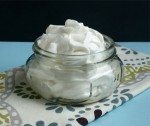
- 1/4 cup Coconut Oil
- 1/4 cup Shea Butter
- 1/8 cup Sesame or Jojoba Oil
- 2 tbsp Beeswax Granules
- 1-2 tbsp zinc Oxide Powder (optional)
- 1 tsp Red Raspberry Oil (Optional)
- 20-30 drops Carrot Seed Oil (Optional)
- Essential oils of your choice (Lavender, Rosemary, Vanilla, Peppermint)
- Using a double boiler (or a small pan over very low heat), melt your coconut oil, sesame or jojoba oil, beeswax and shea butter together. The beeswax will be the last to melt.
- When the beeswax is melted, remove the mixture from the heat and let cool to room temperature. If you are using Zinc Oxide, whisk it in a this point, being careful not to create a lot of dust. If there are some lumps that’s ok, they will break up when you whip the butter in the next step.
- Move the mixture to the fridge for 5-10 minutes. You want it to start to set but still be soft enough to whip.
- Take the mixture out of the fridge and using a stand mixer or hand mixer, start to whip it. Drizzle in the red raspberry seed oil, carrot seed oil (if using) and any essential oils of your choice. Continue whipping until the mixture is light and fluffy.
- Use as you would any regular sunscreen. Application rates will depend on your activity and exposure to water. Store in a glass container in the fridge between uses.



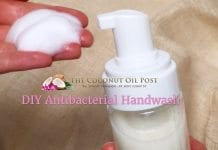
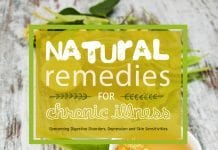

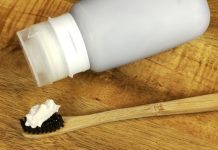

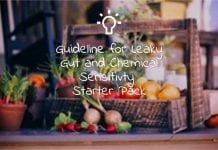
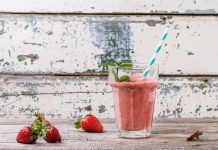



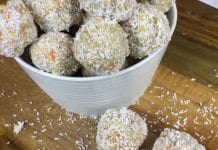
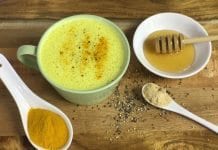

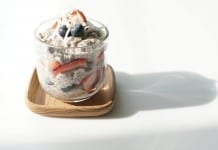

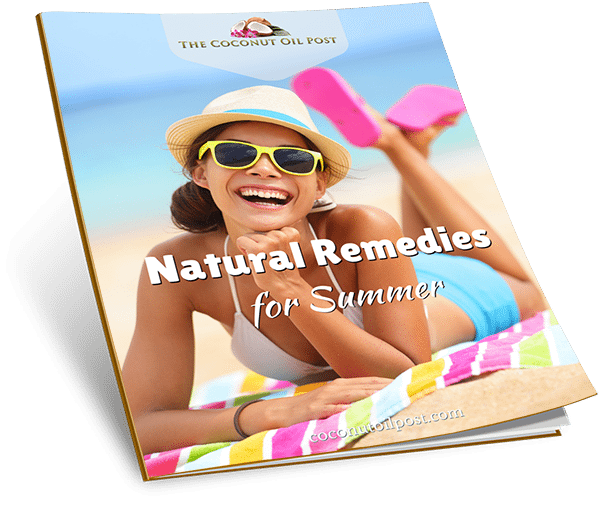












Do you know where Jessica gets her red raspberry oil from? I have never heard of it. Id love to know. Thanks!
[email protected]
Hi Sarah,
Sorry it’s taken so long for me to get back to you. You can buy a product called Herb Pharm, Red Raspberry from iherb.com. If you haven’t purchased from iherb before you can get a bonus discount by clicking on the banner ad on my website. Hope that helps. Cheers Kerry 🙂